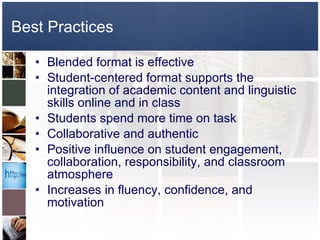Blended intro
- 1. Introduction to Blended/Online Learning Angelika Kraemer & Scott Schopieray CLEAR Summer 2010 Workshop
- 2. Overview Definitions Rationale for blended instruction Advantages, disadvantages, and challenges of blended instruction Best practices
- 3. Definitions: Blended/Hybrid Education Combining the best of F2F and online learning Sloan-C, 2005
- 4. Definitions: Common Terms CALL: Computer-Assisted Language Learning CMC: Computer-Mediated Communication CMS: Course Management System Web 2.0
- 5. CALL Authenticity Extension of class time Immediate feedback Interactive Student-centered Democratization of participation Decreasing grading load Increasing communication Using Generation Web 2.0’s language Computer access Computer literacy Outdated quickly Equipment failure Benefits and Challenges CALICO
- 6. CMC Communicating via the computer Synchronous: Video/voice/text chat Messaging Virtual reality ( Second Life ) Asynchronous: Email/voice mail Blogs Discussion forums/message boards Walls ( MySpace , Facebook ) Wikis Research Report: Improvement in language development Learner-centered More on task More target language use More equal participation
- 7. Benefits of CMC CMC provides opportunities for target language use a voice to those who do not have one (shyer students) a great range of language functions through discourse CMC increases language productivity and output interactive discourse willingness to discuss topics openly and honestly student motivation CMC improves reading comprehension and writing ability attitude toward language learning in general and cultures language development CMC decreases teacher dominance anxiety CMC does not hinder oral proficiency development
- 8. CMS Course web sites to manage instruction Examples MSU: Angel Other commercial CMS: WebCT, Blackboard Free: Nicenet , Wikispaces Common features CMC (chat, discussion board, email) Class roster Grade book Calendar Announcements Attendance keeper/Activity log Lesson folders Online assignments/Tests Virtual office hours
- 9. Web 2.0 Web 2.0: Term coined by O’Reilly in 2004 Signifies web applications that increase user participation, collaboration, interaction Entails social networking technologies such as blogs, wikis, and YouTube Web 1.0: Applications such as Email, discussion forums, chat rooms, and instant messaging The main difference between Web 1.0 and 2.0 lies in the extent of collaboration Web 3.0 : Immersive environments and virtual realities such as Second Life
- 10. Rationale for Blended Instruction Issues in the language classroom Articulation Student perceptions Development of language skills Classroom practices Increase in FL enrollment (Furman, Goldberg, & Lusin, 2007) Increase in blended liberal arts courses (SLOAN-C, 2007) Offer flexibility to students and teachers Might work better for some Desired language/form focus missing in upper division content courses (Polio & Zyzik, 2008) Concurrent acquisition of technology skills
- 11. Your Experience How have you used technology for your teaching? What has worked for you? What has not worked for you?
- 12. Advantages of Blended Instruction Flexibility in time & space (Chenoweth, 2006; Goertler & Winke, 2008) Cost saving – depending on structure (Sanders, 2005; Scida & Saury, 2006) Access to non-traditional students (Chenoweth, 2006; Scida & Saury, 2006; Strambi & Bouvet, 2003) Enrollment increase (Sanders, 2005; Scida & Saury, 2006) Decreasing class size (Sanders, 2005) Increasing course offerings: more sections & LCTLs across institutions Similar language learning outcomes (Chenoweth et al, 2006; Sanders, 2005) More time spend with materials (Sanders, 2005) Positive reviews from students (Kraemer, 2008; Strambi & Bouvet, 2003)
- 13. Disadvantages of Blended Instruction Oral and written proficiency may suffer (Sanders, 2005) Lower motivation (Chenoweth et al., 2006) Online format not successful with less computer literate students (Scida & Saury, 2006)
- 14. Challenges in Blended Instruction Technology failure (Chenoweth et al., 2006) Buy-in from Students (Goertler et al., under review; Winke & Goertler, 2008) Teachers (Arnold, 2007; Goertler & Uzum, under review; Goertler & Winke, 2008) Myths about technology use (Blake, 2001) Lack of normalization (Chambers & Bax, 2006) Teacher preparation (Kessler, 2006, 2007) Student computer literacy and access (Barrette, 2001; Winke & Goertler, 2008) Time commitment: Up to 500% increase (Web-based Education Commission, 2000) Lack of rewards High start-up and development costs
- 15. Best Practices Blended format is effective Student-centered format supports the integration of academic content and linguistic skills online and in class Students spend more time on task Collaborative and authentic Positive influence on student engagement, collaboration, responsibility, and classroom atmosphere Increases in fluency, confidence, and motivation
- 16. Best Practices Instructor involvement Integration of online components in face-to-face instruction Online assignments should enhance learning experience and not be busy work Transparency of functionality, purpose, grading criteria, and due dates Continuous training and feedback Implementation of different assignment types to address students’ differing needs
Editor's Notes
- #4: Courses with a carefully planned blend of traditional classroom instruction and online learning
- #11: Traditional classrooms struggle often with Limited opportunities for students to use the target language Limited access to authentic materials Limited input from a variety of sources Integration of language, literature, and culture
- #16: More language focus in upper-level class Self-evaluations gave students an active role in shaping the course Integration of online components in face-to-face instruction
- #17: More language focus in upper-level class Self-evaluations gave students an active role in shaping the course Integration of online components in face-to-face instruction















